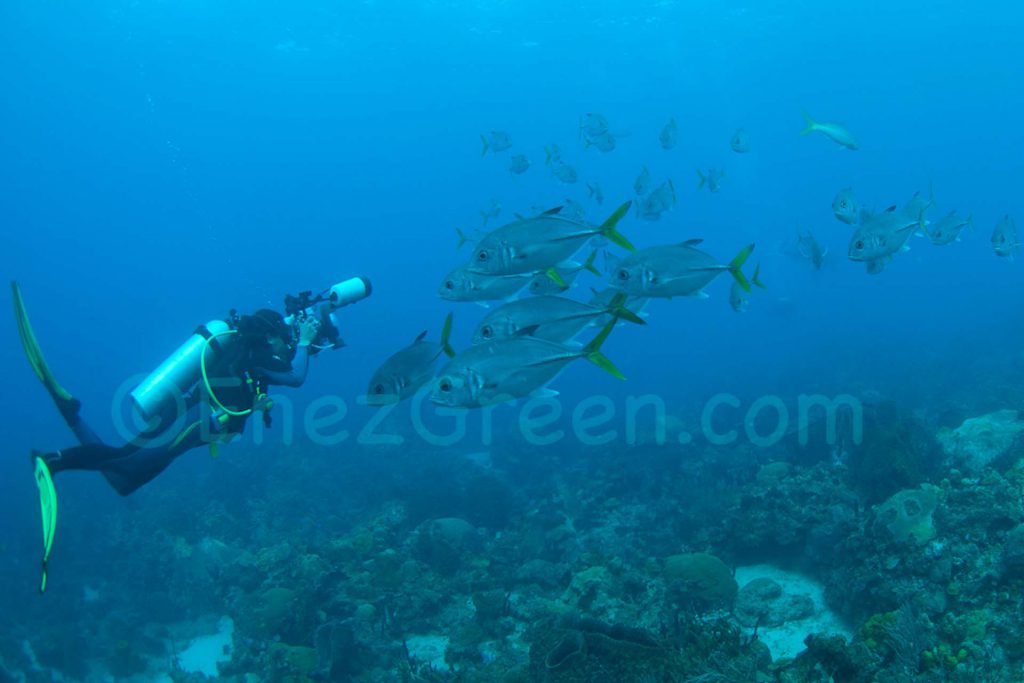Diving at the foot of the Pitons
The spectacle of the Soufrière Pitons rising from the sea is just a foretaste of the view that can be enjoyed under the water, where we discover the continuation of the steep mountains in the form of a drop-off that slopes gently to 500m deep, which boasts a colourful and diverse marine life. The height of the pitons gives an indication of the relatively recent origins of the island, which explains the absence of a lagoon along this coast. Coral reefs are concentrated in a very narrow belt along the coastline and covering almost 60% of the marine area of the site. Since the setting up of the marine protected area, the coastal belt is divided in various areas where activities are regulated. There are several remarkable dive sites in the marine reserve area devoted to underwater activities. We dive at the foot of the majestic Petit Piton, at the Superman’s Flight site – which owes its name to an underwater sequence of the film that was shot there. The underwater panorama is stunning and the words of Peter Butcher come to my mind, “Since the setting up of the park, the marine ecosystem has returned to excellent condition.” I can indeed see for myself! As we drift with the current, the multifaceted hard and soft corals pass before our eyes like a kaleidoscope.
The barrel sponges of Saint Lucia
A scientific study conducted in this marine region of Saint Lucia shows that it is the richest with the identification of 168 fish species as well as some 50 coral species, 8 mollusc species, 11 echinoderm species, 15 arthropod species, 8 spirobranchus species and 14 sponge species. Among the sponge species are fluorescent, digitate and cratered ones, but barrel sponges (Xestospongia muta) are the most curious ones. This sponge called ‘rum barrel’ by the locals is the largest in the Caribbean; it measures up to 2 metres long with a diameter between 1 and 2 metres! It is so deep that a diver could completely hide into it. However, this is not a good idea as there is too great a risk of damaging the sponge. Observations show that this reddish-brown sponge species can reach large proportions in calm areas. The outer part is wrinkled and chapped. I can see a couple of butterfly fish frolicking inside the sponge, safe from predators, and seize the opportunity of taking a few pictures.
Dazzling encounter in the blue
I am so fascinated by this spectacle that I almost forget to follow the group. As I step up the pace to catch up with them, I notice an opaque shape in the blue close to me. It’s a large shoal of bigeye trevally (Caranx Sexfasciatus)! I move away from the drop-off to get closer to them, the current is not too strong and I can swim fast without scaring them. They spring before my eyes like a tank and I find myself in the middle of this glittering pack of fish that continue on their way. This is a fleeting but unforgettable moment. I then get back to the drop-off, where the marine life is prolific. I swim up to Peter and my dive partner, who have spotted a small titan triggerfish. It is far from timid and undulates through the gaps in the corals in front of our cameras. We get back to the surface with star-filled eyes and our cameras filled with fantastic photos.
Situated at the foot of the twin mountain, the Gros Piton, the Coral Garden site is also worth the dive for its rich coral life. The view between 5m and 15m deep is as scenic as above the water surface.
Snorkelling outing in the Anse Chastanet reef
This is an ideal site for novice divers and probably one of the most beautiful sites for snorkelling in St Lucia. Only 10m from the shore of a beautiful fine sand beach, snorkelers and scuba divers can reach in a few strokes the natural underwater park reserve with a coral reef and little caves filled with a great diversity of corals, sponges and reef fish. Encounters with turtles are quite frequent. The remarkably preserved reef in shallow and crystal-clear waters is characterised by a profusion of marine life. Scuba divers and snorkelers alike will enjoy wandering in the coral maze.
Fairyland
Situated opposite the rocky point of Anse Chastanet, Fairyland is exposed to currents, which provides divers, especially photographers and videographers, with great visibility and encounters with some predators such as jackfish and barracudas. Scuba divers can drift above a 12m plateau gently sloping down to around 60m deep, with a multitude of multifaceted and multicoloured sponges, clams, Acropora, brain and table corals. Shoals of fusiliers, snappers, soldier-fish, morays, octopuses, monkfish and parrotfish can also be admired.
The Key Holes Pinnacles
Situated at the foot of the northern cliffs surrounding the Soufrière Bay, The Key Holes Pinnacles is a spectacular site. As its name suggests, the site comprises four volcanic underwater pitons that reach up to 5m beneath the water surface. Damselfish and other reef fish frolic at their top. Divers can enjoy the diversity of landscapes between the pitons and the wealth of wildlife. Butterfly fish, trumpet fish, squirrel fish, tick fish, cow fish, puffer fish, tetraodon fish and globefish roam around the multitude of multicoloured sponges, gorgonian and corals.



